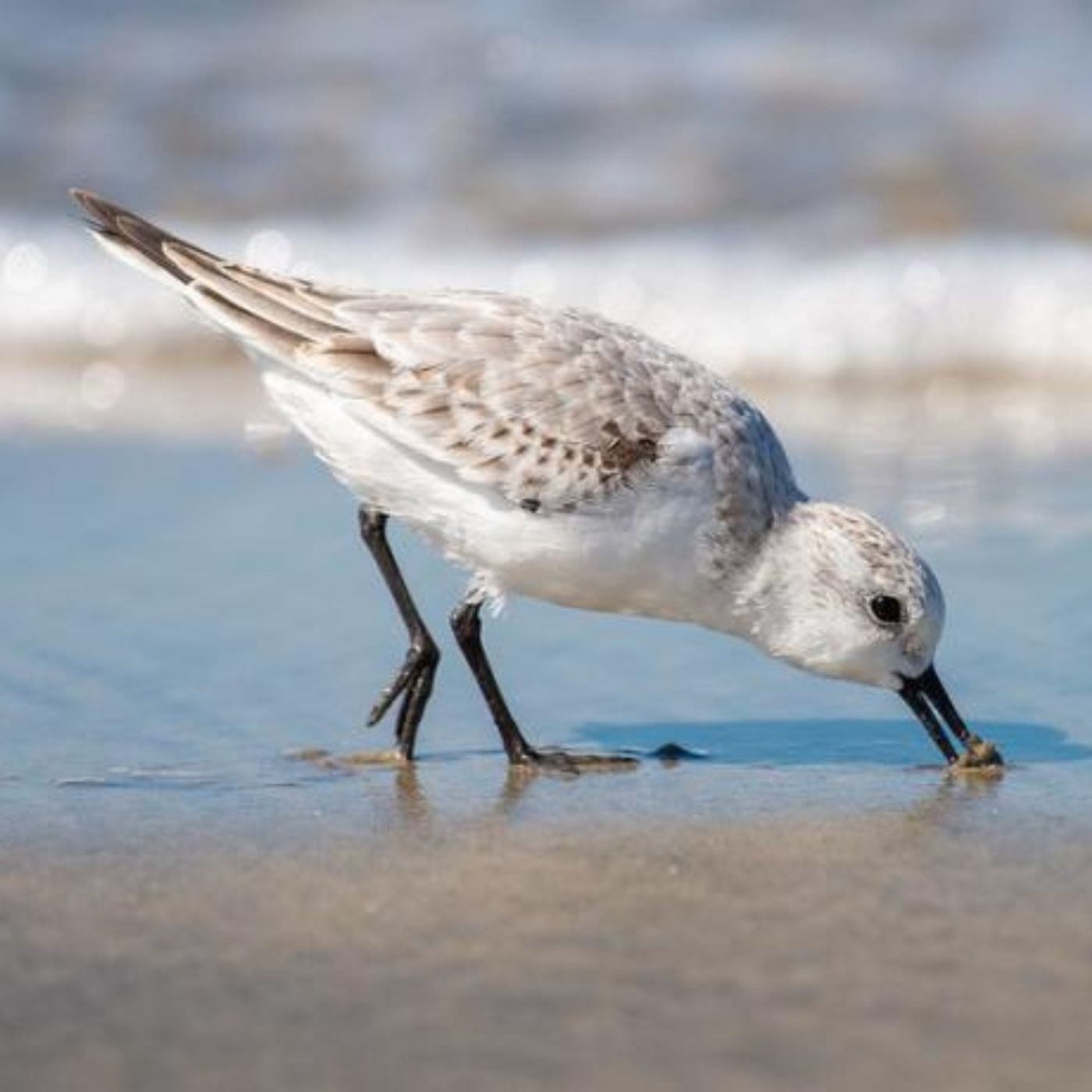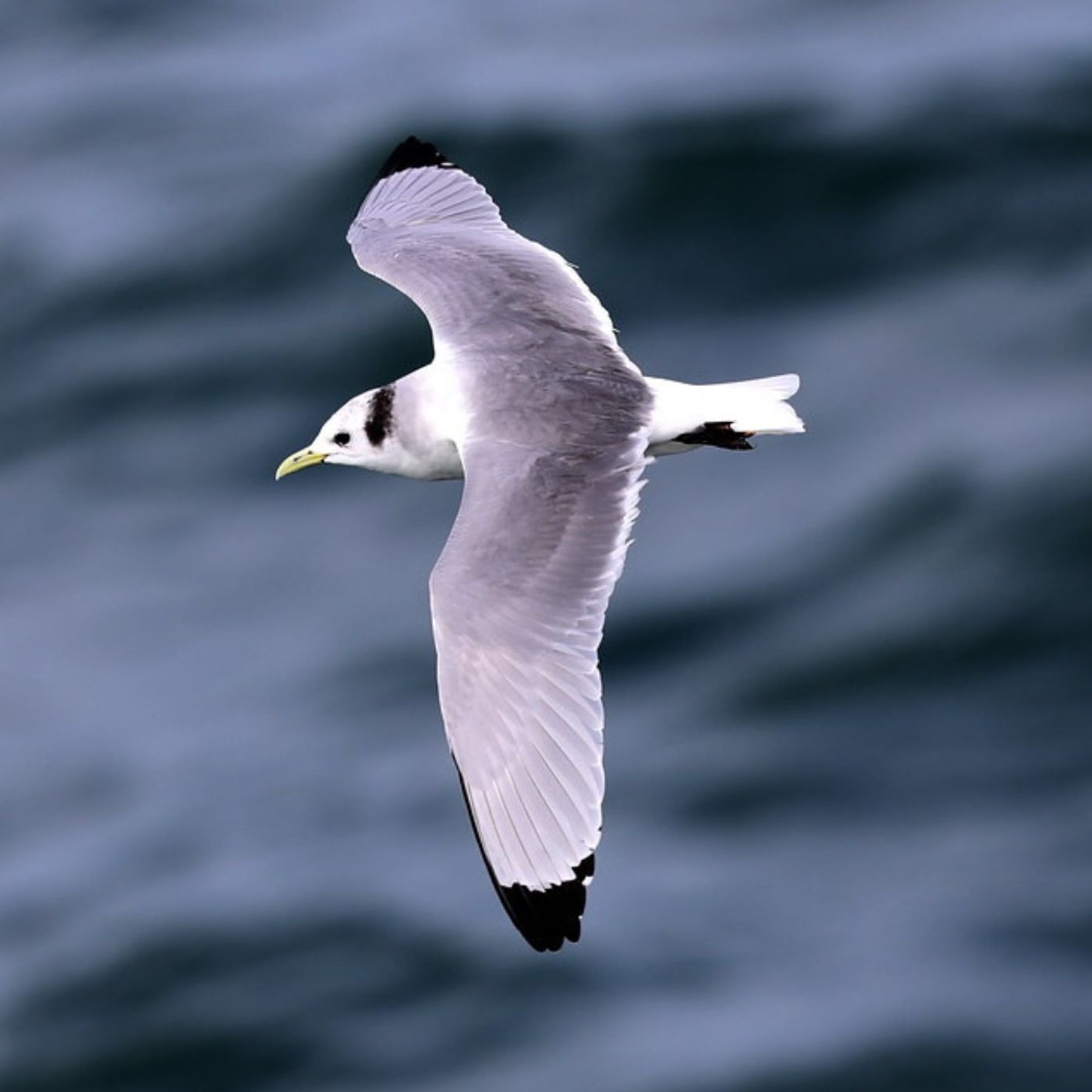Discover BirdNote Daily
BirdNote Daily

1555 Episodes
Reverse
The video game Alba: A Wildlife Adventure lets you have adventures in a stunning virtual landscape while curled up at home with a cup of hot cocoa. The game puts you in the shoes of a birdwatcher and conservationist on a Mediterranean island. As you traverse the animated ecosystems, listen for the calls of over 50 birds, like the Eurasian Sparrowhawk, Northern Shoveler, and Great Cormorant. The game is available on phones, consoles, or your computer.More info and transcript at BirdNote.org.Want more BirdNote? Subscribe to our weekly newsletter. Sign up for BirdNote+ to get ad-free listening and other perks. BirdNote is a nonprofit. Your tax-deductible gift makes these shows possible. Hosted by Simplecast, an AdsWizz company. See pcm.adswizz.com for information about our collection and use of personal data for advertising.
Wendell Berry wrote: "When despair for the world grows in me and I wake in the night at the least sound in fear of what my life and my children's lives may be, I go and lie down where the wood drake rests." Where do you go to rest and renew yourself in nature? Where do you come into the peace of wild things?More info and transcript at BirdNote.org.Want more BirdNote? Subscribe to our weekly newsletter. Sign up for BirdNote+ to get ad-free listening and other perks. BirdNote is a nonprofit. Your tax-deductible gift makes these shows possible. Hosted by Simplecast, an AdsWizz company. See pcm.adswizz.com for information about our collection and use of personal data for advertising.
For folks looking to try birding for the first time, getting started can be daunting. Should you learn every species’ call, every subtle feather pattern before you head out to look for birds? While it’s good to prepare, there’s a risk of scaring yourself out of starting, and preventing the kind of hands-on experiential learning that’s one of the best parts of birding. So when you have the time and energy, just go for it! Learning about birds is the work of a lifetime — that’s why it’s so rewarding.¡Escuche este episodio en BirdNote en Español!More info and transcript at BirdNote.org.Want more BirdNote? Subscribe to our weekly newsletter. Sign up for BirdNote+ to get ad-free listening and other perks. BirdNote is a nonprofit. Your tax-deductible gift makes these shows possible. Hosted by Simplecast, an AdsWizz company. See pcm.adswizz.com for information about our collection and use of personal data for advertising.
At her home in New Orleans, Grammy-winning musical artist Rickie Lee Jones has transformed her yard into a safe haven for birds. By putting out water and feeders, she’s become popular with the local cardinals, doves, and even a crow with a distinctive white wing. The experience has encouraged Rickie to find more ways to take actions to protect birds, like turning off outdoor lights at night and treating windows to prevent fatal collisions.BirdNote is supported by Road Scholar, creating educational travel adventures for adults around the world.More info and transcript at BirdNote.org.Want more BirdNote? Subscribe to our weekly newsletter. Sign up for BirdNote+ to get ad-free listening and other perks. BirdNote is a nonprofit. Your tax-deductible gift makes these shows possible. Hosted by Simplecast, an AdsWizz company. See pcm.adswizz.com for information about our collection and use of personal data for advertising.
Kererū, green-blue pigeons native to New Zealand, like to sun themselves after dining on fruit. But in warm summer months, the bird’s sunbathing has a surprising side-effect. A part of their digestive system called the crop stores their latest snack – where it begins to ferment, eventually making the pigeons drunk! The rotund creatures often get so tipsy that they fall out of trees, prompting compassionate people to deliver them to local bird rescues and let them sober up.More info and transcript at BirdNote.org.Want more BirdNote? Subscribe to our weekly newsletter. Sign up for BirdNote+ to get ad-free listening and other perks. BirdNote is a nonprofit. Your tax-deductible gift makes these shows possible. Hosted by Simplecast, an AdsWizz company. See pcm.adswizz.com for information about our collection and use of personal data for advertising.
The Golden Eagle is a bird of epic proportions not only for their impressive size but also for the many legends they’ve inspired across human history. They are one of the largest eagles in the world with a wingspan of more than seven feet. When the Aztecs saw a Golden Eagle devouring a serpent atop a cactus, they knew they had found their promised land. Today, that powerful raptor graces Mexico’s national shield. In fact, the Golden Eagle appears on the flags and emblems of several countries including Kazakhstan, where nomadic hunters have practiced an ancient form of falconry with Golden Eagles for thousands of years.More info and transcript at BirdNote.org.Want more BirdNote? Subscribe to our weekly newsletter. Sign up for BirdNote+ to get ad-free listening and other perks. BirdNote is a nonprofit. Your tax-deductible gift makes these shows possible. Hosted by Simplecast, an AdsWizz company. See pcm.adswizz.com for information about our collection and use of personal data for advertising.
Polar Bears symbolize the icy landscapes of the far north like no other animal. The bear's way of life — its very survival — is inseparable from the Arctic pack-ice. Less familiar is a remarkable bird that shares with the Polar Bear this vital link to ice: this Ivory Gull. The gulls feed on small fish and other marine life, but also scavenge carcasses, including those left by Polar Bears. Global warming has brought increasing change to the world of ice-dependent species such as the Ivory Gull and Polar Bear.More info and transcript at BirdNote.org.Want more BirdNote? Subscribe to our weekly newsletter. Sign up for BirdNote+ to get ad-free listening and other perks. BirdNote is a nonprofit. Your tax-deductible gift makes these shows possible. Hosted by Simplecast, an AdsWizz company. See pcm.adswizz.com for information about our collection and use of personal data for advertising.
From his start in 1937, the gangly, black-feathered Daffy Duck was a cartoon original: wildly outspoken, volatile, and confrontational — a truly daft duck. Daffy was one of the most memorable characters from the golden age of cartoons, paving the way for other screwball cartoon personalities to come.More info and transcript at BirdNote.org.Want more BirdNote? Subscribe to our weekly newsletter. Sign up for BirdNote+ to get ad-free listening and other perks. BirdNote is a nonprofit. Your tax-deductible gift makes these shows possible. Hosted by Simplecast, an AdsWizz company. See pcm.adswizz.com for information about our collection and use of personal data for advertising.
A century of logging and fire control has taken its toll on the mature pine forests of the West, the preferred nest site for this Lewis's Woodpecker. But there is hope. Lewis's Woodpeckers also nest along rivers in large cottonwoods, trees of little value for timber. Also, many remaining tracts of old-growth ponderosas are protected on public lands, and the trees are growing larger day by day.More info and transcript at BirdNote.org.Want more BirdNote? Subscribe to our weekly newsletter. Sign up for BirdNote+ to get ad-free listening and other perks. BirdNote is a nonprofit. Your tax-deductible gift makes these shows possible. Hosted by Simplecast, an AdsWizz company. See pcm.adswizz.com for information about our collection and use of personal data for advertising.
A bird known as Titanis walleri made its home in Florida just a few million years ago. Titanis, as its name suggests, was titanic indeed — a flightless predator, 5 feet tall, with a massive hooked bill. Titanis and other birds related to it belong to a group some paleontologists call the "terror birds." They were dominant land predators in South America for tens of millions of years. Paleontologists still aren’t clear about why Titanis and its kin went extinct. But whatever factors ended the era of the terror birds also made it a lot less risky to go out and fill your bird feeder.More info and transcript at BirdNote.org.Want more BirdNote? Subscribe to our weekly newsletter. Sign up for BirdNote+ to get ad-free listening and other perks. BirdNote is a nonprofit. Your tax-deductible gift makes these shows possible. Hosted by Simplecast, an AdsWizz company. See pcm.adswizz.com for information about our collection and use of personal data for advertising.
Every bird species uses its wings a little differently, and some are specialized for highly efficient flight. But that means going without other abilities. Swallows and hummingbirds, like a Talamanca Hummingbird, capture their food on the wing, but they can’t walk. Swifts, which are acrobatic in the air, can’t even perch. Yet they dazzle with the maneuverability made possible by their aerodynamic bodies.More info and transcript at BirdNote.org.Want more BirdNote? Subscribe to our weekly newsletter. Sign up for BirdNote+ to get ad-free listening and other perks. BirdNote is a nonprofit. Your tax-deductible gift makes these shows possible. Hosted by Simplecast, an AdsWizz company. See pcm.adswizz.com for information about our collection and use of personal data for advertising.
To hear a Common Loon in the wild during summer, you’ll need to find a northern, freshwater lake where a pair is nesting. But to find that same Common Loon in winter, you’ll likely need to look on a saltwater bay. This shift from fresh to salt water would kill most animals. But loons — along with many ducks and other water birds — have evolved to make that move. It’s possible that breeding adults nest on fresh water in order to save their energy for raising chicks.More info and transcript at BirdNote.org.Want more BirdNote? Subscribe to our weekly newsletter. Sign up for BirdNote+ to get ad-free listening and other perks. BirdNote is a nonprofit. Your tax-deductible gift makes these shows possible. Hosted by Simplecast, an AdsWizz company. See pcm.adswizz.com for information about our collection and use of personal data for advertising.
The Wall of Birds at the Cornell Lab of Ornithology is a towering mural showing nearly 250 life-sized birds across a map of the world. To complete the impressive artwork, artist and scientific illustrator Jane Kim spent 17 months painting day in and day out. Though the experience was often solitary, Jane stayed connected to the outside world through the sounds of wildlife in the nature preserve that surround Cornell Lab.Read more about Jane Kim and the Wall of Birds in Field Notes!More info and transcript at BirdNote.org.Want more BirdNote? Subscribe to our weekly newsletter. Sign up for BirdNote+ to get ad-free listening and other perks. BirdNote is a nonprofit. Your tax-deductible gift makes these shows possible. Hosted by Simplecast, an AdsWizz company. See pcm.adswizz.com for information about our collection and use of personal data for advertising.
Writer and ornithologist J. Drew Lanham shares a note he has written to a Dark-eyed Junco, which he fondly nicknames “snowbird.”More info and transcript at BirdNote.org.Want more BirdNote? Subscribe to our weekly newsletter. Sign up for BirdNote+ to get ad-free listening and other perks. BirdNote is a nonprofit. Your tax-deductible gift makes these shows possible. Hosted by Simplecast, an AdsWizz company. See pcm.adswizz.com for information about our collection and use of personal data for advertising.
In the depths of winter, when open water is frozen over, it can be challenging for birds to stay hydrated. Some birds eat the frozen water all around them. Cedar Waxwings catch snowflakes in mid-air. Black-capped Chickadees drink from dripping icicles. Plenty of other birds scoop up fresh, powdery snow and eat it. It could be worth the calories to melt the snow when searching for liquid water could expose them to predators.More info and transcript at BirdNote.org.Want more BirdNote? Subscribe to our weekly newsletter. Sign up for BirdNote+ to get ad-free listening and other perks. BirdNote is a nonprofit. Your tax-deductible gift makes these shows possible. Hosted by Simplecast, an AdsWizz company. See pcm.adswizz.com for information about our collection and use of personal data for advertising.
Thomas Poulsom is a hobbyist LEGO builder best known for his models of birds. But making birds out of bricks isn't easy. That’s why he uses special pieces to sculpt something entirely different — like when minifigure carrots became a puffin’s legs. A unique piece called a “snot brick” allows him to build in any direction, making it possible to make a round object out of square LEGO bricks.More info and transcript at BirdNote.org.Want more BirdNote? Subscribe to our weekly newsletter. Sign up for BirdNote+ to get ad-free listening and other perks. BirdNote is a nonprofit. Your tax-deductible gift makes these shows possible. Hosted by Simplecast, an AdsWizz company. See pcm.adswizz.com for information about our collection and use of personal data for advertising.
At the visitor center of the Cornell Lab of Ornithology, artist and scientific illustrator Jane Kim painted the Wall of Birds to celebrate the evolution and diversity of birds. Completed in December 2015, the massive mural depicts nearly 250 birds — and several of their ancient predecessors — on a map of the world where each lives. Jane worked closely with scientific advisors to ensure that each portrait accurately represents the bird's features and behaviors, including many species — like the Three-wattled Bellbird — that appear to sing from their place on the wall.Read more about Jane Kim in Field Notes!More info and transcript at BirdNote.org.Want more BirdNote? Subscribe to our weekly newsletter. Sign up for BirdNote+ to get ad-free listening and other perks. BirdNote is a nonprofit. Your tax-deductible gift makes these shows possible. Hosted by Simplecast, an AdsWizz company. See pcm.adswizz.com for information about our collection and use of personal data for advertising.
While many shorebirds have gone south, tiny sandpipers called Sanderlings are easy to find on winter shores. They follow the waves as they lap in and out, probing the swirling sand for prey. They often eat various small crustaceans such as mole crabs, isopods, and amphipods. But they also enjoy miniature clams, polychaete worms, and horseshoe crab eggs. They’ll even catch flying insects or eat plant matter.This episode is dedicated to Deb Rivel, for her many years of board service and generous support of BirdNote.More info and transcript at BirdNote.org.Want more BirdNote? Subscribe to our weekly newsletter. Sign up for BirdNote+ to get ad-free listening and other perks. BirdNote is a nonprofit. Your tax-deductible gift makes these shows possible. Hosted by Simplecast, an AdsWizz company. See pcm.adswizz.com for information about our collection and use of personal data for advertising.
Named for its rhythmic calls, the Black-legged Kittiwake is a dapper, oceanic gull. As described by Roger Tory Peterson, the tips of its pale gray wings "are cut straight across, as if they had been dipped in ink." Unlike many gulls, kittiwakes spend most of the year at sea and are seldom seen inland.More info and transcript at BirdNote.org.Want more BirdNote? Subscribe to our weekly newsletter. Sign up for BirdNote+ to get ad-free listening and other perks. BirdNote is a nonprofit. Your tax-deductible gift makes these shows possible. Hosted by Simplecast, an AdsWizz company. See pcm.adswizz.com for information about our collection and use of personal data for advertising.
The Andean Condor is one of the largest flying birds in the world. With a wingspan that can stretch over 10 feet across, the condor doesn’t flap so much as sail, using rising thermals to glide across the Andes for hours. Once revered in Inca mythology as a messenger of the gods, the Andean Condor now graces the coat of arms of Bolivia, Chile, Colombia, and Ecuador. But like many scavengers, condor populations are declining due to threats like lead poisoning and habitat loss.More info and transcript at BirdNote.org.Want more BirdNote? Subscribe to our weekly newsletter. Sign up for BirdNote+ to get ad-free listening and other perks. BirdNote is a nonprofit. Your tax-deductible gift makes these shows possible. Hosted by Simplecast, an AdsWizz company. See pcm.adswizz.com for information about our collection and use of personal data for advertising.

























Concrete and Driveway Cleaning is important to keep your outdoor spaces looking neat and safe. Over time, dirt, oil stains, and mold can build up, making the surface look dull and slippery. Regular cleaning helps remove these stains and prevents damage. A clean driveway not only improves the look of your home but also makes it safer to walk and drive on. Whether using water, a brush, or a pressure washer, keeping your concrete and driveway clean is a simple way to maintain your home’s beauty and value.https://615softwash.com/concrete-and-driveway-cleaning
⭐⭐⭐⭐⭐ https://nativeplantfinder.nwf.org/ Find a US zip code on the same latitude, as you are. And you find trees + plants & animals etc. For every plant and tree. Enjoy the hunt. (^^,)
Yeps humans do it too. (^^,) From Republic of Tuva is what you hear last in this episode. AND you will find more here to watch. : https://m.youtube.com/watch?v=Mkm9N_T_mgk&list=PLFvjMOwDLtDC-Qk4DkviD9IYq_cb9GfiI&index=35&pp=gAQBiAQB8AUB ,Ohhh and this lady is a very good singer too. https://m.youtube.com/watch?v=Mkm9N_T_mgk&list=PLFvjMOwDLtDC-Qk4DkviD9IYq_cb9GfiI&index=35&pp=gAQBiAQB8AUB ENJOY And remember that all people do this, when they speak and sing.
Love this https://midhunp.com/
wow https://shalushaan.com
I love how creative and insightful these episodes are. Thank you
how lovely!
,
This podcast is wonderful & so informative. Thanks for sharing.